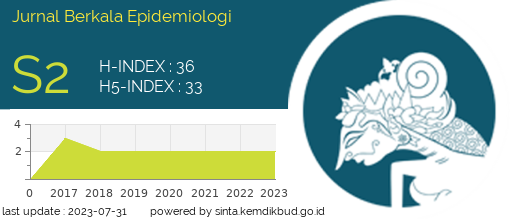Analysis Determinants of Postpartum Maternal Mortality at Sidoarjo Regency in 2012
Downloads
The Maternal Mortality Ratio (MMR) in Indonesia remains high, i.e approximately 359 per 100.000 life birth (IDHS 2012). MMR is an indicator of mother's health, especially the risk of being death for a mother while pregnant and delivery. Mostly the majority of MMR is occurring in the first two days after delivery and care after giving birth services required to manage complication. Sidoarjo regency has high postpartum maternal mortality case, so it is necessary to study determinants influencing postpartum maternal mortality in that regency. This research aimed to analyze the determinants that influence postpartum maternal mortality. This research was an observational research using case control study. Number of samples was 21 cases and 43 controls. Data were analyzed by univariate analysis, bivariate analysis with chi-square test, and multivariate analysis with multiple logistic regressions. The result showed that the determinants which influence postpartum maternal mortality according to multivariate analysis were pre-eclampsia / eclampsia (OR = 20,98; 95%CI : 2,250 – 323,416; p = 0,008) and delivery complication (OR = 5,47; 95%CI=1,356 – 22,022; p = 0,017). Probability of mother to have risk of postpartum maternal mortality with all those risk factors above was 92,9%. This research recommended are need to detect early sign of pregnancy, delivery, and post delivery complication, especially danger sign of pre-eclampsia/eclampsia, referral preparation, and pregnancy planning.
Armagustini, Yetti. 2010. Determinan Kejadian Komplikasi Persalinan di Indonesia (Analisis Data Sekunder Survei Demografi dan Kesehatan Indonesia Tahun 2007). Tesis. Fakultas Kesehatan Masyarakat Universitas Indonesia.
BPS dan Macro International. 2003. Survei Demografi dan Kesehatan Indonesia Tahun 2002/2003. Badan Pusat Statistik dan Macro International, Calverton, Maryland, USA.
BPS dan Macro International. 2008. Indonesia Demographic and Health Survey (Survei Demografi dan Kesehatan Indonesia) 2007. http://dhsprogram.com/pubs/pdf/FR218/FR218%5B27August2010%5D.pdf (sitasi 28 Januari 2013).
BPS dan Macro International. 2013. Indonesia Demographic and Health Survey (Survei Demografi dan Kesehatan Indonesia) 2012. http://dhsprogram.com/pubs/pdf/FR275/FR27 5.pdf (sitasi 10 Maret 2014).
Carroli, Gueillermo., Rooney, Cleone., dan Villar, Jose. 2001. How Effective is Antenatal Care in Preventing Maternal Mortality and Serious Morbidity? An Overview of The Evidence. Pediatric and Perinatal Epidemiology 15 (Suppl.1) p. 1 – 42.Blackwell Science, Ltd.
Dhaher, Enas, Rafael T Mikolajczyk, Annette E Maxwell, dan Alexander Krämer. 2008. Factors associated with lack of postnatal care among Palestinian women : A Cross-sectional Study of Three Clinics in The West Bank. BMC Pregnancy and Childbirth 2008, 8 : 26. http://www.biomedcentral.com/1471-2393/8/26 (sitasi 3 April 2013).
Depkes RI. 2012. Pedoman pelayanan antenatal terpadu, edisi kedua. Ditjen Bina Gizi dan Kesehatan Ibu dan Anak. Jakarta.
Dinas Kesehatan Provinsi Jawa Timur, 2013. Profil Kesehatan Provinsi Jawa Timur Tahun 2012. http://www.depkes.go.id/downloads/PROFIL_
KES_PROVINSI_2012/15_Profil_Kes.Prov.Ja
waTimur_2012.pdf (sitasi 10 Februari 2014).
Djaja, Sarimawar dan Suwandono, Agus. 2006. The Determinants of Maternal Morbidity in Indonesia. Regional Health Forum WHO South-East Asia Region Volume 4. WHO.
Fibriana, Arulita Ika. 2007. Faktor – Faktor Risiko yang Mempengaruhi Kematian Maternal (Studi Kasus di Kabupaten Cilacap). Tesis. Program Pasca Sarjana Universitas Diponegoro.
http://eprints.undip.ac.id/16634/ARULITA_IKA_FIBRIANA.pdf (sitasi 2Februari 2013).
Kjí¦rgaard, Hanne. 2009. Incidence and Outcome of Dystocia in The Active Phase of Labor in Term Nulliparous Women with Spontaneous Labor Onset. Acta Obstetrica et Gynecologica Scandinavia. 88(4): 402–407.
Manuaba, Ida Bagus Gde. 2010. Ilmu Kebidanan, Penyakit Kandungan dan Keluarga Berencana untuk Pendidikan Bidan. Jakarta : EGC
Mochtar, Roestam. 2008. Sinopsis Obstetri (Obstetri Operatif dan Sosial) Jilid II. Jakarta: ECG.
Rochjati, Pudji. 2007. Skrining Antenatal Pada Ibu Hamil (Pengenalan Faktor Risiko) Edisi 2. Surabaya: Airlangga University Press.
Saifuddin, Abdul Bari., Djamhoer Martaadisoebrata, dan R. Sulaiman Sastrawinata. 2005. Bunga Rampai Obstetri dan Ginekologi Sosial. Jakarta; YBP-SP.
Sharma, Gaurav. 2012. Maternal, Perinatal, and Neonatal Mortality in South-East Asia Region. Asian Journal of Epidemiology 5(1): 1 – 14.
Sines E, Uzma Syed, Steve Wall, dan Heidi Worley. 2007. Postnatal Care : A Critical Opportunity to Save Mothers and Newborns. Population Reference Bureau Policy Perspective on Newborn Health January 2007.
Thornton C, Dahlen H, Korda A, dan Hennessy A. 2013. The Incidence of Preeclampsia and Eclampsia and Associated Maternal Mortality in Australia from Population-linked Datasets : 2000 – 2008. American Journal Obstetry Gynecology 2013 Jun.208(6): 476.e1-5. http://www.ncbi.nlm.nih.gov/pubmed/2346704 8 (sitasi 14 Januari 2014).
Tjiptosiswono D, Budiningtyas, Widyaningsih W. 2004. Kematian Maternal di RSUD dr. Moewardi Surakarta Tahun 1998 – 2002. Kumpulan Makalah Ilmiah PIT XIV POGI 11 – 15 Juli 2004. Bandung.
UNICEF. 2012. Ringkasan Kajian Kesehatan Ibu dan Anak (UNICEF Indonesia). http://www.unicef.or.id (sitasi 6 Februari 2013).
WHO dan UNICEF. 2007. Maternal and Perinatal Death Inquiry and Response. Department of Reproductive Health and Research WHO. Geneva.
WHO. 2010. Reduction of maternal mortality. A joint WHO/ UNFPA/ UNICEF/World Bank statement. Geneva.
WHO. 2012. Trends in Maternal Mortality : 1990 to 2010 WHO, UNICEF, UNFPA, and The World Bank Estimates. https://www.unfpa.org/webdav/site/global/shar ed/documents/publications/2012/Trends_in_m aternal_mortality_A4-1.pdf (sitasi 27 Maret 2013).
Wibowo B, Rachimhadhi T. 2012. Preeklamsia dan Eklamsia. Ilmu Kebidanan, edisi kesepuluh. Jakarta : YBP-SP.
- Every manuscript submitted to must observe the policy and terms set by the Jurnal Berkala Epidemiologi
- Publication rights to manuscript content published by the Jurnal Berkala Epidemiologi is owned by the journal with the consent and approval of the author(s) concerned. (download copyright agreement)
- Complete texts of electronically published manuscripts can be accessed free of charge if used for educational and research purposes according to copyright regulations.

JBE by Universitas Airlangga is licensed under a Creative Commons Attribution-ShareAlike 4.0 International License.























